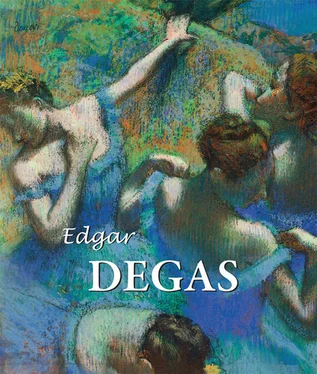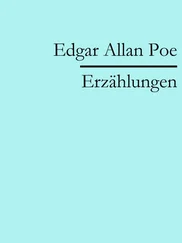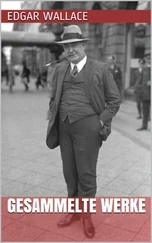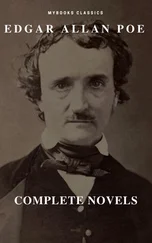The good-humoured and warm-hearted behaviour of the women in the brothel prints anticipates the mood of Guy de Maupassant’s famous short story The House of Madame Tellier , published in 1881, in which the prostitutes lavish their warmth and affection on a young girl taking her first communion. ‘All the women were eager to fondle her, seeking an outlet for those affectionate demonstrations, that habit of caressing induced by their profession, which had impelled them to kiss the ducks in the railway carriage.’
Among the most delightful of the prints is The Name Day of the Madame , which Degas later reworked in pastel. A portly madame, dressed in respectable black and looking horribly like a caricature of the Widow of Windsor (Queen Victoria), is surrounded by girls wearing only shoes and lavender stockings who offer her bouquets of flowers.
Once again we are reminded of La Maison Tellier , in which the women of the house ‘threw their arms round Madame Tellier and hugged her, as if she was an indulgent mother overflowing with kindness and good will’. The stocky women depicted in these monotype prints belong to a different physical type – almost, it would seem, to a different species – from the statuesque laundresses, the more slender dancers and the tightly-corseted middle-class ladies. This sturdily thickset type was clearly heavily in demand by 19 th-century clients of prostitutes. The adjective ‘stout’ is used with great approbation throughout The Pretty Women of Paris .
Many of the women are described in terms strongly reminiscent of Degas’ images. Marie Kolb is ‘a pleasant, little ball of fat’, and Blanche Querette ‘a most lascivious dumpling, and every bit of her fleshy frame is deserving of worship’. Berthe Laetitia is ‘short, and her well-rounded form is developed to the utmost, all her bones being covered with firm layers of elastic flesh, and her breasts and buttocks being sights to behold’. Marie Martin is ‘a fine, dark, Spanish-looking, matronly woman, with semi-globes like a Dutch sailor’s wench, and a pair of hips and a monumental backside that would make a Turk go off like a bottle of ginger-beer on a hot day’. Berthe Mallet is ‘the very woman for a man who likes to wallow in a mass of white flesh…’ Several of these prints, as well as many of the later pastel and oil Toilettes , show Degas’ fascination with large and fleshy buttocks. Here, too, he shared tastes with the compilers of The Pretty Women of Paris , who were enthusiastic about the ‘enormous, fascinating buttocks’ of Ernestine Desclauzes.
As for Zulmar Bouffar, the brilliant operetta star who created the role of the pretty glove-maker Gabrielle in Offenbach’s La Vie Parisienne , they tell us that ‘her best parts are her posterior beauties: even the Hottentot Venus cannot boast such a well-formed pair of sculptured marble buttocks’.
The residents of Degas’ brothels differ from the bland, idealised nudes exhibited at the Paris Salons not only in their physical proportions and facial types, but also in their frank display of abundant pubic hair. Nowhere is the sexual schizophrenia of the 19 thcentury more apparent than in the contrast between the hairless perfection of 19 th-century academic nudes and the relish with which the pubic hair of the women in The Pretty Women of Paris is itemised in the most minute and precise detail.
So we learn that Bacri ‘can boast the best bush that ever grew below a moll’s navel’; that the mons veneris of Laure Decroze ‘is protected by a splendid, soft, curly chestnut bush’; ‘The neat body and flowing locks of golden hue’ of Emilie Kessler ‘will be sure to excite desire in the male, especially when he makes the discovery that her tangled bush is as black as night, affording a rare and pleasing contrast.’ The brothel prints display a caricature and gently satirical element that is virtually unique in Degas’ work. This is most apparent in Degas’ mockery of the bashful bowler- or top-hat wearing clients, dressed as always in the black uniform of the ‘undertaker’s mutes’.
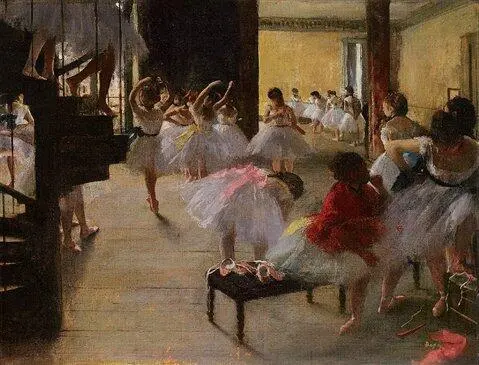
The Dance Class, c. 1873.
Oil on canvas, 47.6 × 62.2 cm.
Corcoran Gallery of Art, Washington, D.C.
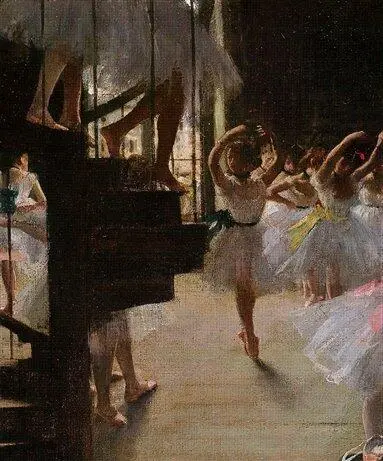
The Dance Class (detail), c. 1873.
Oil on canvas, 47.6 × 62.2 cm.
Corcoran Gallery of Art, Washington, D.C.
In The Serious Client , for example, a curvaceous prostitute (whose body is modelled almost entirely in Degas’ fingerprints) reaches out to encourage the timid bowler-wearing client. In several of these images, the notorious acerbity and terseness of Degas’ conversational wit finds a nice visual equivalent in the oblique and abbreviated way that he refers to the presence or approach of the male client.
In the Salon shows a black-suited client with a top hat and stiffly-starched shirt collar entering a room filled with prostitutes disporting themselves in the most carelessly abandoned poses. In Repose and The Customer , we see no more than the client’s nose and a narrow strip of the black fabric of his trousers. One of the most voluptuous of the brothel monotype prints, Two Women (Scene in a Brothel) , combines two potent male fantasies: lesbianism and interracial sex.
If we are to believe the authors of The Pretty Women of Paris , lesbianism, or ‘tribadism’ as they so quaintly put it, was common practice amongst Parisian prostitutes, although its extent may well have become exaggerated in their overheated imaginations. These lesbian encounters are described in the book with that curious mixture of moral disapproval and salivating prurience that still characterises attitudes to sex in much of the British popular press.
So we read of the ‘disgusting caresses’ common to French prostitutes and the ‘Sapphic ties, of which Parisian unfortunates are generally so fond’, and of Janvier, ‘an insatiable devotee of lesbian love’, who ‘pursues her prey in the corridors of the Opera like a man’, of Nina Melcy, mistress of a British Member of Parliament, who ‘adores her own sex, but only when there is an important debate in the House’, and of Juliette Grandville who is ‘often Sappho by day and Messalina by night, rushing eagerly to the arms of her masculine adorer with the glorious traces of some girlish victim’s excitement on her feverish ruby lips.’ To see lesbian activity was clearly exciting to many men in 19 th-century Paris.
Конец ознакомительного фрагмента.
Текст предоставлен ООО «ЛитРес».
Прочитайте эту книгу целиком, на ЛитРес.
Безопасно оплатить книгу можно банковской картой Visa, MasterCard, Maestro, со счета мобильного телефона, с платежного терминала, в салоне МТС или Связной, через PayPal, WebMoney, Яндекс.Деньги, QIWI Кошелек, бонусными картами или другим удобным Вам способом.
